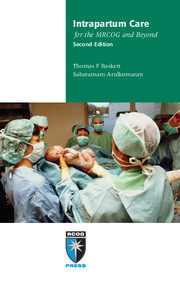Book contents
- Frontmatter
- Contents
- Preface
- Abbreviations
- 1 Improving intrapartum care
- 2 First stage of labour
- 3 Second stage of labour
- 4 Fetal surveillance in labour
- 5 Third stage of labour
- 6 Lower genital tract trauma
- 7 Induction of labour
- 8 Preterm labour and prelabour rupture of membranes
- 9 Assisted vaginal delivery
- 10 Shoulder dystocia
- 11 Breech vaginal delivery
- 12 Twin and triplet delivery
- 13 Caesarean section
- 14 Vaginal birth after caesarean section
- 15 Uterine rupture
- 16 Emergency obstetric hysterectomy
- 17 Cord prolapse
- 18 Antepartum haemorrhage
- 19 Postpartum haemorrhage
- 20 Acute uterine inversion
- 21 Amniotic fluid embolism
- 22 Disseminated intravascular coagulation
- 23 Acute tocolysis
- 24 Severe pre-eclampsia and eclampsia
- 25 Neonatal resuscitation
- 26 Perinatal loss: management of late fetal death and stillbirth
- Index
17 - Cord prolapse
Published online by Cambridge University Press: 05 July 2014
- Frontmatter
- Contents
- Preface
- Abbreviations
- 1 Improving intrapartum care
- 2 First stage of labour
- 3 Second stage of labour
- 4 Fetal surveillance in labour
- 5 Third stage of labour
- 6 Lower genital tract trauma
- 7 Induction of labour
- 8 Preterm labour and prelabour rupture of membranes
- 9 Assisted vaginal delivery
- 10 Shoulder dystocia
- 11 Breech vaginal delivery
- 12 Twin and triplet delivery
- 13 Caesarean section
- 14 Vaginal birth after caesarean section
- 15 Uterine rupture
- 16 Emergency obstetric hysterectomy
- 17 Cord prolapse
- 18 Antepartum haemorrhage
- 19 Postpartum haemorrhage
- 20 Acute uterine inversion
- 21 Amniotic fluid embolism
- 22 Disseminated intravascular coagulation
- 23 Acute tocolysis
- 24 Severe pre-eclampsia and eclampsia
- 25 Neonatal resuscitation
- 26 Perinatal loss: management of late fetal death and stillbirth
- Index
Summary
Cord prolapse is the quintessential obstetric emergency. It occurs when part of the umbilical cord descends below the fetal presenting part. If the membranes are intact, the condition is called cord presentation. The frequency range is about 1/200 to 1/600 deliveries. The fetal risk is from hypoxia owing to physical compression of the umbilical cord vessels between the fetal presenting part and maternal tissues, or spasm of the vessels as a result of the colder temperature should the cord prolapse through the introitus. The perinatal mortality rate can be as high as 9%, even in well-equipped hospitals.
Aetiology
FACTORS THAT PREDISPOSE TO CORD PROLAPSE
Fetal
• Preterm labour and low birthweight
• Malpresentations
• Anomaly
• Multiple pregnancy
Placental
• Placenta praevia
Amniotic fluid
• Polyhydramnios
• Prelabour rupture of membranes: spontaneous and amniotomy
• Rupture of membranes in labour: spontaneous and amniotomy
Maternal
• Pelvic tumours, such as cervical fibroid
• Pelvic contraction
• Obstetric manoeuvres: rotation of fetal head, version, amnioinfusion
From the list of factors that predispose to cord prolapse, it can be seen that anything that interferes with the close application of the presenting part to the lower uterine segment and cervix will increase the likelihood of cord prolapse. Many of these factors are interrelated, such as preterm labour, malpresentations, multiple pregnancy and polyhydramnios.
- Type
- Chapter
- Information
- Intrapartum Care for the MRCOG and Beyond , pp. 189 - 194Publisher: Cambridge University PressPrint publication year: 2011



